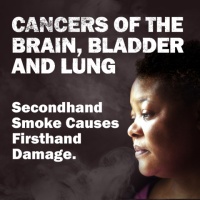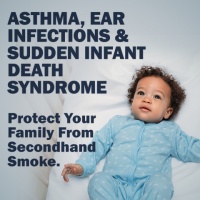Bruce Hartzell
Original Communications, Inc.
PH: 310.458.3382
Cell: 310.433.9879
(Black PR Wire) LOS ANGELES--(BUSINESS WIRE)-- Today, the Los Angeles County Department of Public Health (Public Health) launched “Protect Your Home from Secondhand Smoke”, a public education campaign informing LA County residents on the dangers of secondhand smoke exposure and encouraging all residents to maintain a smoke-free home. The campaign depicts how smoke can travel through doorways and ventilation to reach nonsmokers, including children, and emphasizes illnesses that are caused by secondhand smoke exposure. It includes video, radio, online and social media advertisements, as well as outdoor advertisements such as posters at convenience store locations. The campaign will be in English, Spanish, and Korean.
Decades of research have shown that secondhand smoke causes serious health problems to both children and adults who are exposed to it. Secondhand smoke contains hundreds of toxic chemicals, and the United States Surgeon General has concluded there is no risk-free level of exposure. The California Air Resources Board (ARB) also identified secondhand smoke, as a toxic air contaminant. This means that secondhand smoke is an airborne toxic substance that may cause and/or contribute to death or serious illness. Secondhand smoke exposure to infants and children can increase the risks of ear infections, respiratory problems like asthma and sudden infant death syndrome (SIDS). Exposure to secondhand smoke also increases the risks of cancer, heart disease, stroke, and asthma in adults. Smoking can also be responsible for deaths and injuries among both smokers and nonsmokers from fires in the home.
For people who live in multi-unit housing like apartments and condominiums, there can also be a risk of secondhand smoke exposure even if they maintain a smoke-free home. Secondhand smoke can move from one home into another when smoke travels from another unit, on a patio, on a balcony, or in an outdoor courtyard. Secondhand smoke can travel through doors, windows, hallways, plumbing, electrical systems, cabinets, closets, ceiling fans, fireplaces, and ventilation systems.
Resources for smoke-free housing are available at SmokeFreeHomesLA.com.
“Secondhand smoke is toxic and incredibly dangerous to children, adults, and even pets,” said Barbara Ferrer, PhD, MPH, MEd, Director of Public Health. “Everyone, smokers and nonsmokers alike, can pledge to make every room a smoke-free space, as well as outside on patios or balconies, and near entryways. And if you live in a building with multiple units or apartments where there is secondhand smoke, I encourage you to check with your landlord or building manager about the policies around smoking on the property, as many cities and buildings in LA County already have no-smoking policies in place.”
For residents in multi-unit housing, there are steps you can take to address secondhand smoke exposure, including speaking with your neighbors or by asking your landlord or property manager to make certain areas or all areas of the building smoke-free. There are also local coalitions working to reduce secondhand smoke in home environments.
The Department of Public Health is committed to protecting and improving the health of over 10 million residents of Los Angeles County. Through a variety of programs, community partnerships and services, Public Health oversees environmental health, disease control, and community and family health. Nationally accredited by the Public Health Accreditation Board, the Los Angeles County Department of Public Health comprises nearly 4,100 employees and has an annual budget of $1 billion. To learn more about Los Angeles County Public Health, visit PublicHealth.LACounty.gov, and follow LA County Public Health on social media at twitter.com/LAPublicHealth, facebook.com/LAPublicHealth, instagram.com/LApublichealth and youtube.com/LAPublicHealth.
Los Angeles County Department of Public Health works to protect health, prevent disease, and promote health and well-being.
Source: Los Angeles County Department of Public Health



